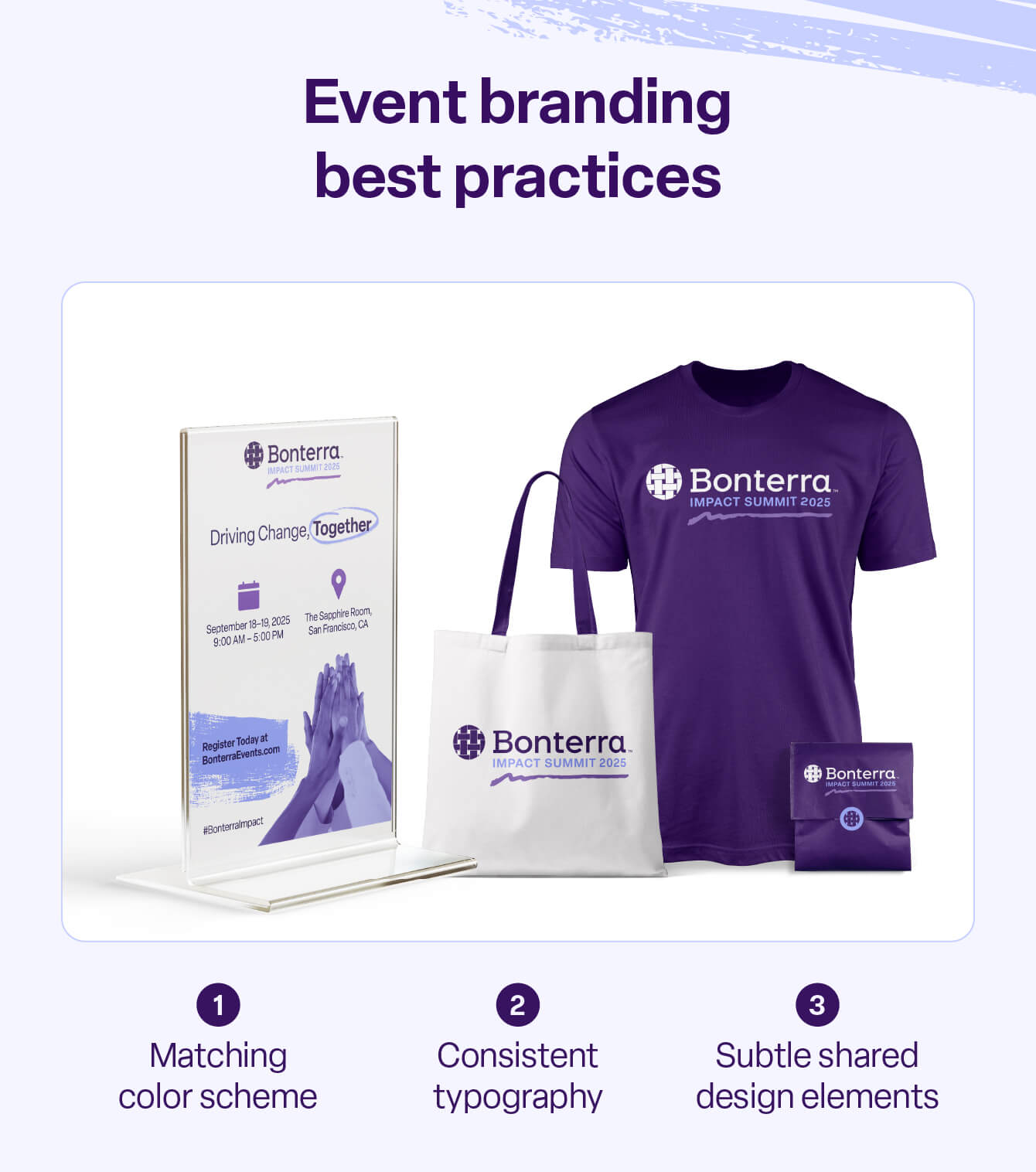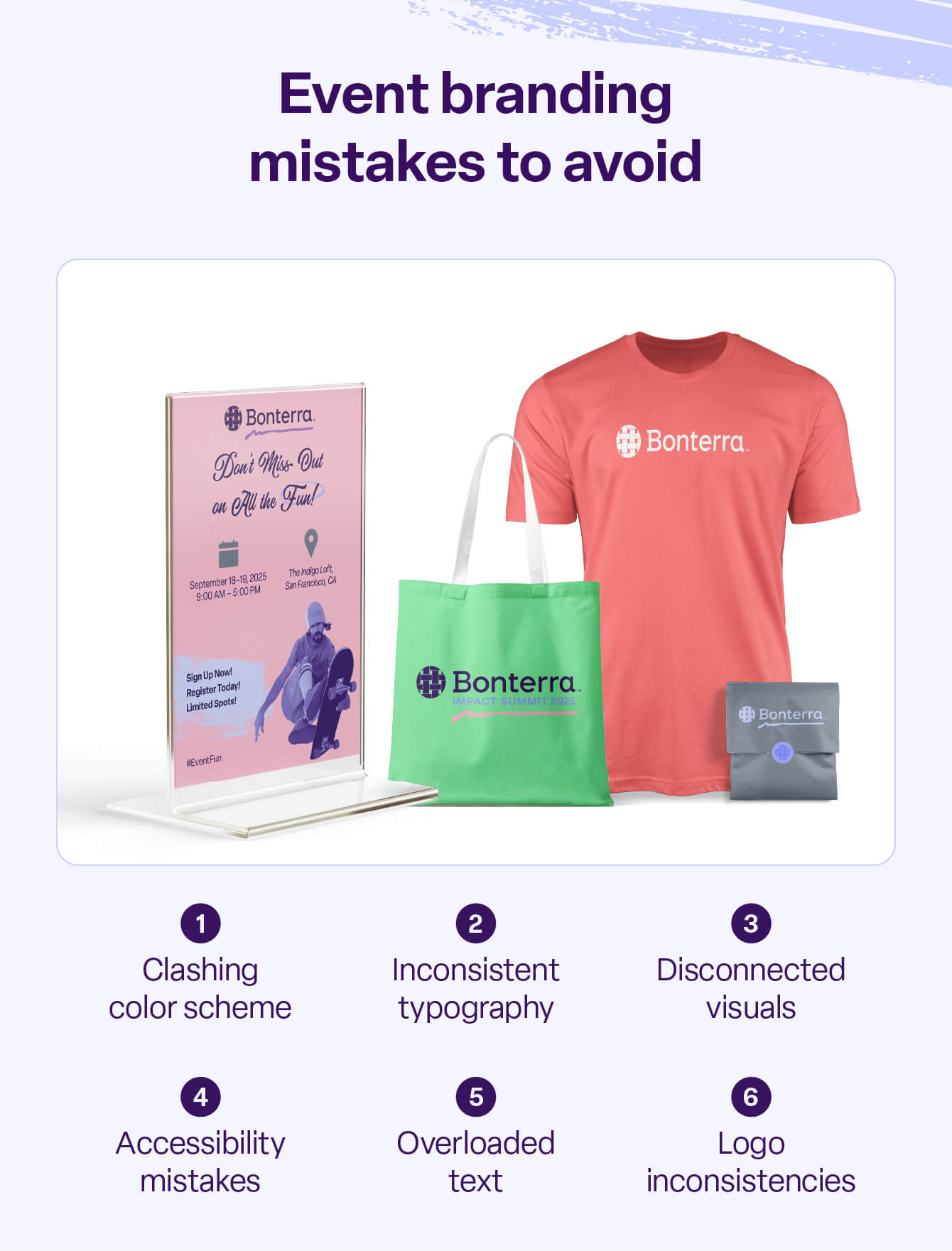Event branding tips to make your organization stand out

Key takeaways
Event branding is how nonprofit organizations create an event identity to reach their audiences.
Branding includes visual components, content, customer service, and communication.
Strong event branding builds trust, increases reach, and cultivates loyalty.
When developing an event branding strategy, focus on consistency, messaging, inclusivity, and connection to your mission.
Nonprofit events are a great way to boost your mission, with nearly every organization hosting events to raise funds and awareness. That’s why event branding is so critical. Without it, you risk your organization’s event getting lost in the shuffle, which may negatively impact your ability to achieve your mission.
Strong nonprofit marketing strategies are key to branding your event. More than just getting the word out about the event, compelling branding lets you convey what’s special about your organization, what will make your event memorable, and how it all ties to your mission.
In this guide, we explain what event branding is, how it benefits a nonprofit, and provide ideas and strategies to do it well.
What is event branding?
Event branding is the strategy and process of messaging and marketing an event to expand its reach and attract attendees. Ultimately, event branding should do more than simply advertise the date and location of the event.
When branding an event, you want to invoke the feelings you want your audience to associate with your organization. This makes your mission and organization more memorable while building awareness.
Benefits of event branding
Event branding has a big impact — in fact, in a survey, 93% of nonprofit professionals said they believe a strong brand identity positively impacts donor engagement.
Here are a few benefits of event branding:
- Gain recognition and grow your following: Effective branding with consistent messaging and visuals makes your organization recognizable. Over time, this can contribute to supporters coming back and sharing your mission with others.
- Attract interest from prospective attendees: Professional, eye-catching flyers, social media, and web content signal that your event will be well-organized and offer value to attendees.
- Engage with vendors and sponsors: A consistent brand helps potential sponsors and vendors feel confident that your event will showcase their brand effectively, which can help you get more sponsors.
- Cultivate trust: Branding that shows your organization is mission-driven and invested in a meaningful experience can make attendees more likely to support you in the future, building long-term relationships and strengthening your reputation.

Key elements of effective event branding for nonprofits
When deciding how to do event marketing, start by understanding the key elements.
Visual identity and signage
Your brand’s visual identity comprises your logo, color scheme, graphics, font, signage, and other visual collateral. It’s important to make sure these all align for a cohesive brand identity. People should look at your collateral and recognize your organization.
Messaging and tone
Tie your messaging and tone back to your mission, keeping everything consistent. Any event slogans, taglines, or other content should reflect your organization’s values and reflect your mission statement and goals.
Relationship-building customer service
A major part of branding — that doesn’t always come to mind when working on a brand strategy — is customer service. By providing an excellent experience to attendees and supporters, you create free advertising for your nonprofit.
The hospitality of your event, service of your staff, and responsiveness of your organization as a whole all reinforce how people perceive you.
Website and mobile app
First, make sure your organization’s website and mobile app are up to date. When you’re planning an event, add related information and helpful features.
For example, you might create an event microsite that includes a page with event details and a link to register. On the back end, you could set up tracking so you understand how many attendees came in from different channels.
Swag and branded merchandise
Use your event as a way to send your branding out into the world by sending everyone home with swag. The best bet is to offer practical items like tote bags, water bottles, or t-shirts that are likely to be used. As supporters make use of their free swag, everyone they come into contact with will get exposure to your brand.
Post-event follow-ups
Branding isn’t over when the event ends. Instead, stay top-of-mind by sending a personalized email thanking guests for attending and donating. You can also use this as a time to gather data via a survey and share information about your event’s impact. Staying in touch with your supporters will cultivate a longer-term relationship and build loyalty.
15 Event branding ideas and strategies
Getting your event brand strategy off the ground requires creativity and a willingness to try new things. We’ve pulled together a list of event branding examples and ideas you can test with your organization.
1. Create a theme
Select a theme that directly ties into your mission. For example, a children’s charity might set up a cupcake-themed event called “Cupcakes for Kids.”
Once you have a theme, incorporate it into cohesive branding that leverages existing organizational brand components. For instance, you could design invitations that feature cupcakes alongside your logo and font. Together, this will help prospective attendees remember your event and your organization.
2. Design an event hashtag
To get the word out more effectively on social media, create a unique hashtag for your event. Keep it short and easy while interesting enough to remember. Something like, “#DonutsForDogs” fits the bill.
Then, include the hashtag on:
- Social media marketing materials
- Event invitations
- Onsite screens
- Onsite signage
Not only does this help you expand your reach, it also gives you a way to track user-generated content and engagement.
3. Personalize attendee touchpoints
Include personal details throughout your event to really make it donor-centric. For instance, you can:
- Print name tags for each attendee
- Show names on a check-in screen
- Send personalized thank-you emails or gifts
Moreover, you can segment your email list to send more impactful messages, whether that’s “We can’t wait to see you at your first event” or “Thank you for continuing your decade of support.” This fosters connection with your audience.
4. Brand your stage and signage
Just like with the rest of your marketing materials, use consistent designs, logos, and colors for your day-of materials and equipment. For instance, project your logo onto your stage backdrop and set table tents with your logo and hashtag. This serves to reinforce your brand and show your organization’s professionalism.
5. Use branded photo ops
Set up photo-worthy backdrops that tie to your mission, like a photo wall of adoptable animals for a rescue nonprofit. Position your hashtag or logo in the design as well, so every Instagram story or grid post enhances brand recognition.
To encourage attendees’ photos, set up an interactive photo booth. As a bonus, this also offers a fun way to keep attendees engaged.
6. Incorporate your mission into presentations
Ensure your event’s speakers, slide decks, and videos all effectively reflect your organization’s cause. For example, consider including your mission statement on the introduction slides.
This alignment with your mission strengthens your brand and creates a shared sense of purpose. When the mission remains front and center of your event, attendees will leave inspired.
7. Build consistency across digital platforms
Keep your website, emails, and social media posts in line with the look and feel of the event by using relevant colors and font choices. To help avoid mistakes, use branded templates to keep things consistent. This consistency helps you build trust and excitement for the event.
8. Offer branded swag strategically
Useful swag like tote bags, notebooks, or water bottles are both useful and fun, and they help you promote your brand long after your event ends. By strategically giving swag that people will use, you increase the chances that your reach will expand every time they use their cup or bag.
9. Engage with interactive experiences
Set up workshops, polls, or games that keep attendees involved and entertained. You could gamify your event with a scavenger hunt or offer a trivia contest including facts about your mission and achievements.
If you’re also using branded photo ops, you can make that interactive by suggesting people compete for likes or engagement.
10. Highlight sponsors in a branded way
If you’ve secured event sponsorships, highlight them by incorporating their names into your signage, slides, or swag without overshadowing your own organization’s brand. You can also spotlight them on stage or in other content. This can enhance sponsor satisfaction and pave the way to future partnerships.
11. Share behind-the-scenes content
Everyone’s curious what happens behind the scenes, so why not share some of that content with your supporters? Offer a glimpse into what goes into an event by showing setup, rehearsals, and staff interviews on social media via Stories, Reels, or TikToks. This can help create buzz leading up to the event while also humanizing your organization.
12. Collect feedback
If you send post-event thank-you messaging, include a branded survey to ask about attendees’ experience, impressions, and perception of your mission. This will give your organization valuable insights, and it also shows your supporters that you care about their opinions and experiences.
13. Leverage live streaming or recordings
To further your reach beyond those in your local area, consider livestreaming or recording key parts of your event. This way, those who couldn’t attend in person can still get a taste of your event. You can also share select highlights or recaps.
Over time, you can select different parts of recorded content to reuse in campaigns or social media posts. Bonterra DonorDrive offers livestreaming, social media integration, and more.
14. Partner with influencers or advocates
Build relationships with people who are aligned with your cause, such as:
- Local community leaders
- Advocates
- Micro-influencers
- Local celebrities or personalities
Provide them with branded materials or content to share with their audiences. This will expand your reach to an audience who may not have found you otherwise. It also boosts credibility to your branding.
15. Follow up with branded post-event communications
Set up marketing automation to help you manage communications before, during, and after your event. To really secure relationships with your event guests, send a strong, branded follow-up message after the event.
You can do this by:
- Incorporating recordings
- Sharing event photos
- Reinforcing the impact on your mission by sharing how much money was raised
Using Bonterra’s multichannel campaign tools, like DonorDrive, lets you plan and tailor your outreach across email, social media, and the web, maximizing reach and results.
Common event branding mistakes to avoid
Even when you feel confident that you know the event marketing best practices, it’s imperative to avoid some common branding mistakes, including the following:
- Inconsistent visuals across channels: Using different visuals, like fonts or logos, across channels can cause confusion and weaken trust. While you can certainly use multiple colors or fonts as part of your brand, consistency is key.
- Overloading attendees with messages: Sending too much information, too often, can overwhelm attendees with noise. This leads to the risk of them unsubscribing from your list or avoiding your events.
- Ignoring accessibility: Missing key areas of accessibility, like physical access to event spaces or captions on videos, can give the impression your organization isn’t inclusive.
- Forgetting to connect branding to your mission: Keeping your content disconnected from your mission weakens your overall branding efforts and can feel disjointed.

How to measure the impact of your event branding
Once you’ve developed and implemented your event branding and hosted your event, it’s time to see what was — and wasn’t — successful. This looks different for fundraising events than it does for brand awareness events, but there are plenty of common ways to track your impact:
- Attendee engagement data: Look at how many attendees RSVPed and how many actually attended. That gives you the first glimpse into your success, but you can dig even deeper by analyzing their engagement. Did they participate in activities or bid at the auction?
- Survey feedback: Learn about your audience’s impression of your branding through a survey. You can ask questions about their perception of your organization, what piqued their interest in the event, why they attended, and how it impacted their feelings about the organization.
- Social media reach and sentiment: Scan social media to see if people are mentioning or tagging your organization or sharing photos from the event. Notice, too, if your organization’s posts are seeing an increase in reactions, shares, or engagement.
- Donor or supporter conversions: This may be a stronger metric for fundraising events, where you’re clearly making a financial ask and tracking exactly how much comes in. But even with events simply for brand awareness, take a look at any increase in donations, volunteer inquiries, or other supporter conversions.
Turn every event into a lasting impression
Event branding requires creativity and intention, but it’s a crucial part of hosting a successful, meaningful event. Strong branding requires a strong connection to your mission and consistency that makes it easy for supporters to remember you. When done right, event branding deepens trust from the community and drives future support.
You don’t have to do it on your own, though. Robust event and fundraising software like Bonterra can help you plan, coordinate, market, and host impactful events that enhance your reputation and increase your funds.
Get started today and see how Bonterra can help boost your event branding efforts.
FAQs
What are the 5 C’s of branding
There isn’t a singular agreement on the five C’s of branding, but a common list is:
- Clarity: Make sure the audience understands who you are and what you hope to achieve.
- Consistency: Use the same visuals and brand voice across all of your materials.
- Content: Publish information that aligns with your audience and offers valuable information.
- Community: Foster a sense of connection and help your audience feel they’re all in it together.
- Communication: Share your brand’s message to build a connection with your audience.
These are particularly important when branding a nonprofit event, as you want to remain connected with your mission and your dedicated supporters.
How should I align an event theme with my company’s core values?
To align an event theme with your organization’s values, select a theme that reflects your mission and reinforces your objectives as an organization. For example, an animal rescue nonprofit might host a race event to raise funds. They could publicize the theme as a chance to run or walk with your dog instead of simply branding it as a race.
What measurable KPIs prove that event branding improved engagement?
To determine whether your event branding improved engagement, keep track of KPIs like donor conversions, volunteer requests, attendee attendance and participation, survey scores, and social media metrics. In the long term, look at whether you see an increase in funds raised or a better ability to achieve your organization’s mission.
How can nonprofits use event branding to strengthen donor relationships?
Nonprofits can use event branding to strengthen relationships by aligning their branding with the organization’s mission at every touchpoint. Over time, this will continue to create memorable experiences for supporters and sponsors.
What’s the difference between event branding and event marketing?
Event branding covers the entire identity and experience of your event, and even of your nonprofit organization as a whole. Marketing, on the other hand, is specifically the promotion and outreach of your event. In other words, branding includes how you use visuals to present your event and invoke a feeling — as well as a tie to your organization’s mission — while marketing is the signage you create with your brand identity.
Work with Bonterra



